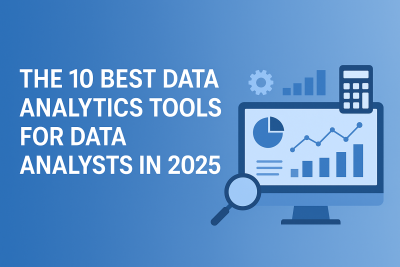In 2025, the competitive landscape is more data-driven than ever. Businesses of all sizes are moving beyond basic reporting to harness the power of advanced analytics, turning raw information into strategic assets. The right analytics tools are no longer a luxury, they are a necessity for staying ahead. Here's a deeper look into the modern data analytics ecosystem.
Key Trends Shaping the Analytics Landscape
- AI-Powered Insights – Tools are increasingly integrating AI for predictive and prescriptive analytics.
- No-Code Platforms – Empowering non-technical users to perform advanced analytics.
- Cloud-Native Solutions – Ensuring scalability and real-time access from anywhere.
- Enhanced Data Security – Stronger compliance measures with global regulations like GDPR and CCPA.
Recommended Articles:
Criteria for Selecting the Best Data Analytics Tools Ease of Use and Learning Curve
A good analytics tool should balance powerful features with an intuitive interface. For 2025, expect platforms with guided workflows, drag-and-drop features, and AI assistance.
- The Power of Seamless Data Integration: In the modern business world, data rarely lives in one place. It's scattered across various platforms: your accounting software, your customer relationship management (CRM) system, your social media accounts, and your website analytics. For an analytics tool to be truly effective, it must have robust data integration capabilities. This isn't just a convenient feature; it's the foundation of a unified data strategy.
- Whether for a small startup or a multinational enterprise, scalability and performance ensure that a tool can handle increasing data volume and user demand without a hit to its performance. The right tool should grow with your business, not become a bottleneck.
- Finding the Right Balance: Cost vs. Value: When choosing a data analytics tool, the price tag is only one part of the equation. A low-cost tool might seem appealing, but if it lacks essential features or fails to scale with your business, it could end up costing you more in lost opportunities and wasted time. The real goal is to find the perfect balance where the value you gain from the tool—in terms of insights, efficiency, and growth, far outweighs its cost.
Top 10 Data Analytics Tools for 2025
1. Microsoft Power BI – Best for Business Intelligence: Power BI remains the leader in business intelligence, offering real-time dashboards, AI insights, and tight integration with Microsoft 365.
2. Tableau – Best for Interactive Dashboards: Known for stunning visualizations, Tableau allows deep data exploration and storytelling with interactive charts.
3. Google Looker Studio – Best Free Tool for Beginners: Ideal for startups and small businesses, it offers free, cloud-based analytics with seamless Google integration.
4. Qlik Sense – Best for Self-Service Analytics: A strong choice for organizations wanting decentralized, user-driven analytics with a powerful associative data model.
5. IBM Congo's Analytics – Best for Enterprise Solutions: Enterprise-grade tool combining advanced reporting, AI insights, and strong governance features.
6. SAS Analytics – Best for Statistical Analysis: Preferred in research, healthcare, and banking for robust statistical modeling capabilities.
7. Rapid Miner – Best for Data Science and Machine Learning: Offers a drag-and-drop interface for complex data science workflows, including predictive modeling.
8. Apache Spark – Best for Big Data Processing: An open-source powerhouse for large-scale data processing and distributed computing.
9. SQL – Best for Direct Database Queries: A must-know language for querying, managing, and analyzing structured data.
10. Alteryx – Best for Data Preparation and Automation: Specializes in cleaning, blending, and automating data workflows without heavy coding.
Comparative Analysis of Tools Pricing Overview
- Free Tools – Google Looker Studio, SQL (open-source versions)
- Mid-Tier – Power BI, Tableau Public, Qlik Sense (starting plans)
- Enterprise – SAS, IBM Congo's, Alteryx, Tableau Server, Rapid Miner Pro
Best Use Cases for Each Tool
- Business Dashboards – Power BI, Tableau
- Data Science – Rapid Miner, SAS
- Big Data – Apache Spark, SQL
- Small Business – Google Looker Studio, Power BI Free
Strengths and Weaknesses
- Strengths – Advanced visualization, AI integration, scalability.
- Weaknesses – Some tools have steep learning curves or high costs.
Future Outlook: The Evolution of Data Analytics Tools
- AI-Powered Analytics: More tools will offer predictive and prescriptive analytics with natural language query capabilities.
- No-Code and Low-Code Platforms: The rise of drag-and-drop analytics will enable non-technical teams to build complex reports.
- Cloud-Based Analytics Adoption: By 2025, most analytics tools will operate entirely in the cloud for real-time collaboration.
Final Recommendations
Selecting the right data analytics tool is a strategic decision that depends on your unique business needs. The best approach is not to find a single, "perfect" tool, but rather to find one that aligns with your team's skills, your data volume, and your desired outcomes.
- Start Small and Grow: For many small businesses, it's wise to begin with user-friendly and cost-effective tools like Microsoft Excel or Google Looker Studio. These are great for foundational reporting and visualization. As your data volume and analytical needs increase, you can scale up to more robust platforms.
- Embrace a Multi-Tool Strategy: No single tool does everything perfectly. By combining tools, you can create a powerful and efficient workflow. For instance, you might use SQL to efficiently query and manage large datasets, and then use a tool like Power BI or Tableau to create compelling visualizations and interactive dashboards. This allows you to leverage the strengths of each tool to maximize your insights and streamline your processes.
Ready to master these tools and stand out as a data analyst?
At ECR Academy, we offer hands-on training in Excel, Power BI, SQL, and Python—designed to take you from beginner to professional. Enroll today at ECR Academy and transform raw data into powerful insights!
Frequently Asked Questions
1. What is the most popular data analytics tool in 2025?
Microsoft Power BI remains the most widely used globally.
2. Which data analytics tool is best for beginners?
Google Looker Studio, due to its simplicity and free access.
3. Are paid data analytics tools worth the investment?
Yes, if advanced features, security, and scalability are business priorities.
4. What skills do I need to use data analytics tools effectively?
Basic statistics, data cleaning, visualization, and domain knowledge.
5. Which tools are best for big data analytics?
Apache Spark, SQL, and certain configurations of SAS.
6. Can I use more than one data analytics tool at a time?
Absolutely — hybrid workflows are common in professional settings.
7. How do I choose the right data analytics tool for my business?
Consider budget, team expertise, data sources, and scalability needs.

 Data Analysis
Data Analysis
 0 comment
0 comment
 16 Aug, 2025
16 Aug, 2025

SOPHIA OLISE
Data Analyst
Olise Sophia Amarachi is a passionate and purpose-driven data analyst and digital skills advocate based in Nigeria. With a strong foundation in Excel, Power BI, and SQL, she empowers others—especially young people and corps members—through practical training, tech mentorship, and values-based leadership. Sophia’s journey into data analysis began during her NYSC year in Abia State, where she committed herself to learning and growing from scratch. Today, she shares her knowledge through online classes, challenges, and hands-on projects, including dashboards and reports that translate complex data into clear insights.
0 comment